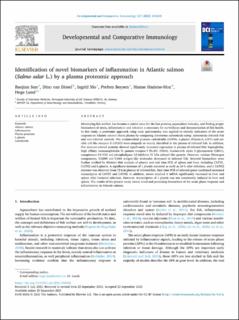| dc.description.abstract | Monitoring fish welfare has become a central issue for the fast-growing aquaculture industry, and finding proper biomarkers of stress, inflammation and infection is necessary for surveillance and documentation of fish health. In this study, a proteomic approach using mass spectrometry was applied to identify indicators of the acute response in Atlantic salmon blood plasma by comparing Aeromonas salmonicida subsp. salmonicida infected fish and non-infected controls. The antimicrobial proteins cathelicidin (CATH), L-plastin (Plastin-2, LCP1) and soluble toll-like receptor 5 (sTLR5) were uniquely or mainly identified in the plasma of infected fish. In addition, five immune-related proteins showed significantly increased expression in plasma of infected fish: haptoglobin, high affinity immunoglobulin Fc gamma receptor I (FcγR1, CD64), leucine-rich alpha 2 glycoprotein (LRG1), complement C4 (C4) and phospholipase A2 inhibitor 31 kDa subunit-like protein. However, various fibrinogen components, CD209 and CD44 antigen-like molecules decreased in infected fish. Selected biomarkers were further verified by Western blot analysis of plasma and real time PCR of spleen and liver, including CATH1, CATH2 and L-plastin. A significant increase of L-plastin occurred as early as 24 h after infection, and a CATH2 increase was observed from 72 h in plasma of infected fish. Real time PCR of selected genes confirmed increased transcription of CATH1 and CATH2. In addition, serum amyloid A mRNA significantly increased in liver and spleen after bacterial infection. However, transcription of L-plastin was not consistently induced in liver and spleen. The results of the present study reveal novel and promising biomarkers of the acute phase response and inflammation in Atlantic salmon. | en_US |

